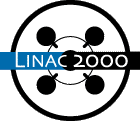
P.N. OSTROUMOV, K.W. SHEPARD (ANL), V.N. ASEEV (INR), A.A. KOLOMIETS (ITEP)
This paper describes a design for the front end of a RIA driver linac which can accept and simultaneously accelerate two charge states of uranium from an ECR ion source. This mode of operation increases the beam current available for the heaviest ions by a factor of two. In particular, we discuss the 12 MeV/u prestripper section of the RIA driver linac including LEBT, RFQ, MEBT and superconducting linac, with a total voltage of 112 MV. The LEBT consists of two bunchers and electrostatic quadrupoles. The fundamental frequency of both bunchers is equal to the first subharmonic of the RFQ frequency. The first buncher is a multiharmonic one and assigned to accept more than 80% of each charge state and form extremely low longitudinal emittance (total emittance is lower than 1.5 pi keV/u nsec) output of the RFQ. The second buncher is located directly in the front of the RFQ and matches average velocities of each charge state to the design input velocity of the RFQ. The electrostatic quadrupoles provide charge-insensitive focussing and transverse matching to the RFQ acceptance. We present the full 3D simulation of a two-charge state uranium beam, including space charge forces in the LEBT and RFQ, realistic distributions of all electric and magnetic fields along the whole prestripper linac, and the effects of errors, evaluated for several design options for the prestripper linac. The results indicate that the design goal of accelerating two charge states while minimizing the effective emittance growth is achievable.
* Work supported by the U. S. Department of Energy under contract W-31-109-ENG-38
Comments or Questions to
linac2000@slac.stanford.edu